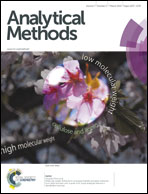The analysis of azocyclotin and cyhexatin residues in fruits using ultrahigh-performance liquid chromatography-tandem mass spectrometry†
Abstract
Ultrahigh-performance liquid chromatography coupled to electrospray positive ionization and tandem mass spectrometry (UHPLC-ESI(+)-MS/MS) was applied for the quantification and identification of azocyclotin and cyhexatin in fruit samples. Homogenized samples were extracted with acetonitrile, without derivatization, and then a cleanup step using Florisil SPE cartridge was applied. Under the optimized conditions, recovery studies were carried out on spiked matrices (4 fruits including orange, apple, peach and grape) with azocyclotin and cyhexatin at spiking levels of 2–200 μg kg−1. The mean recoveries were 71–105%, with relative standard deviations in the range of 2–13%. The quantification of analytes was carried out using the most sensitive transition for every compound and by “matrix-matched” standards calibration. The method limits of detection (S/N 3 : 1) achieved are in the range of 0.1–0.3 μg kg−1. The intra-day precision (n = 5) for analytes in fruit samples spiked at an intermediate level (20 μg kg−1) was between 6% and 10%, and the inter-day precision (n = 10) was between 8% and 13%.


 Please wait while we load your content...
Please wait while we load your content...